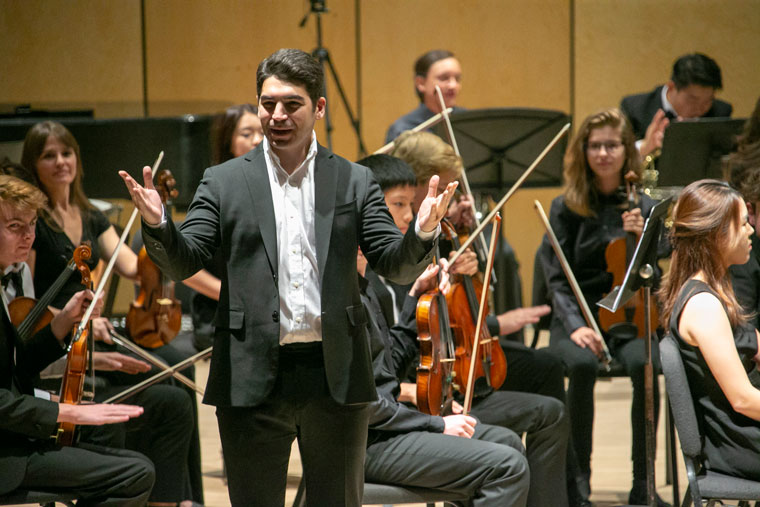
With the prospects of a glorious mountain sunset, unfazed by the smoke of distant fires tempered by light breezes, the yearly ritual of the inaugural concert of the newly formed Idyllwild Arts Academy Orchestra began with the usual necessities. The introduction of the proceedings by Music Department Chair Dr. Jeanette Louise Yaryan and of the program itself by Gregory Robbins, the program’s new conductor, as all appeared in orderly stage presentation.
The music began as demonstrably emphatic as could be with Beethoven’s “Fidelio” Overture (that is, to the opera itself, and not one of the three “Leonore” overtures which are really concert pieces full of what would today be characterized as “spoiler alerts”) providing the vigor in the four bar opening string statement and the horn response surviving a bit of a technical glitch to ensure the opera’s principal message of “freedom above all.”
Robbins exercised the utmost control over his appointed forces by letting the string contingent favor the winds and the brass (again, necessarily augmented by alumni and guest artists) in setting forth the panoply of related motifs in a generally solid mixture of contrasting timbres seasoned with varying emotional punctuation, as required.
Following a short break in the proceedings (due to technical microphonal tinkering with the piano), the ever-appreciative audience welcomed the soloist and Idyllwild Arts Academy Concerto Competition winner Tong Daisy Su. From the very start of the piece — the beginning traversal of the keyboard in response to the timpanist’s roll — the clear execution of Grieg’s second theme as well as her finger dexterity and methodical attack in the composer’s virtuoso passages gave every indication that the above-mentioned award was very well deserved indeed.
The only wish — expressed by this listener among others — was that the whole of the concerto could have been presented, barring the inevitable time constraints. A wholly satisfying performance, yes. Why spare the audience two more movements of the composer’s romantic and nationalistic expressions? Is that too strong of an aspiration — to hear more of Su’s virtuosity or Robbins’ deft accompaniment? Perhaps one might apply the maxim that “enough is enough” in any case, the public’s applause at the movement’s conclusion stood as a kind of consolation.
The expectation of the orchestral ambitions evinced in both the Beethoven and Grieg were carried over into the final piece (a personal favorite of Robbins as well as this listener’s), Mendelssohn’s fourth symphony. This proved another exercise in orchestral contrast, not only in the dance-influenced outer movements, but also in the reflective spirit of the inner movements, where the symphonic thrust of Mendelssohn’s idols — Bach as well as Beethoven — come to the fore.
Conducting with the requisite dash and vivacity, all was accomplished to the general appreciative body of auditors, and Robbins generally acknowledged his little but formidable ensemble with both individual and collective accolades.
And so, the beginning concert of the season ended with the merriment of the presto finale as the audience departed to the music of sunny Italy into the Californian wilderness, fully illuminated by moonlight and brisk, temperate winds. One expects a speedy return of this refreshing elemental mixture in future concerts of these forces.
In memory of another music appreciator, the late Jan Jaspers-Fayer.












